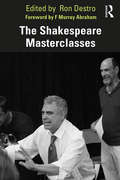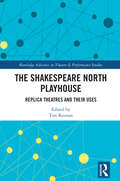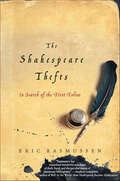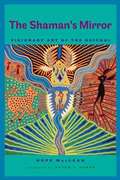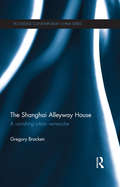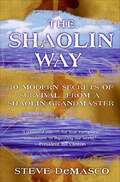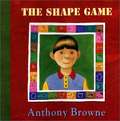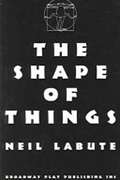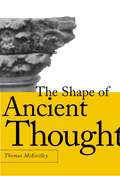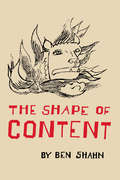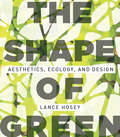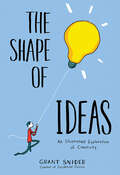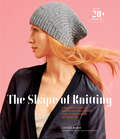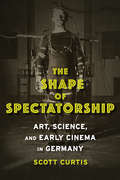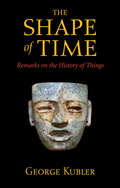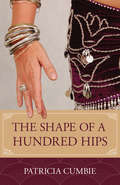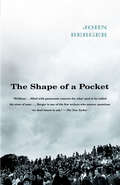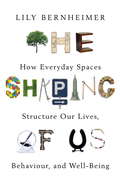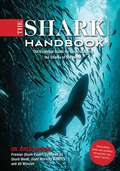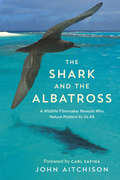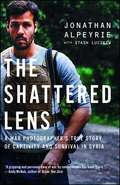- Table View
- List View
The Shakespeare Masterclasses
by Ron DestroThe Shakespeare Masterclasses is a collection of rare interviews from many of the world’s most renowned Shakespearean actors, exploring their varied approaches to topics including character creation, script analysis, acting for the stage and the camera, rehearsal, preparation, and collaboration. Ron Destro’s insightful and revealing conversations with thirteen accomplished artists provide the reader with the invaluable experience of sitting in the classroom with each of these masters. A selection of Shakespeare plays including Hamlet, The Winter’s Tale, King Lear, and The Tempest are examined to explore antithesis, line-endings, rhyme and meter, method acting, and the artistry of a good director. In addition to critical analysis of their vocation, the actors weave through personal and humorous anecdotes and favorite acting moments, and offer useful movement and vocal exercises. This book offers a lens into the creative process of world-acclaimed actors, to expose an abundance of tips, tools, and fascinating stories about the acting profession that will be of crucial interest to acting students, directors, drama teachers, Shakespeare performance scholars, and general theatre fans more broadly.
The Shakespeare North Playhouse: Replica Theatres and Their Uses (ISSN)
by Tim KeenanThis collection celebrates the opening of the Shakespeare North Playhouse (SNP). After discussion of its genesis and development by four people pivotal to its progress at different stages of the project, this book explores different aspects of the SNP’s purpose and functions across three broad categories: buildings and spaces, practices and performance, and community arts and education. Various chapters offer answers to fundamental questions about replica theatres, including: Why do we build them? What do they do? How do we use them? In the course of these discussions, the purposes, potential, and programming of the SNP are discussed in relation to other Globe-type replicas in the UK and beyond. Contributors to this collection analyse key academic and practice-based concerns within their fields of expertise connected to the use (and misuse) of replica theatres to suggest the ways in which they can be used to drive research and practice in contemporary Shakespearean performance, connect with young people, and serve local communities.This book will appeal to academics, students, and practitioners interested in historical and contemporary approaches to Shakespeare in the fields covered. It should also appeal to general readers with an interest in the topics, particularly in Merseyside and the North-West region.
The Shakespeare Thefts: In Search of the First Folios
by Eric RasmussenPart literary detective story, part Shakespearean lore, The Shakespeare Thefts will charm the Bard's many fans.The first edition of Shakespeare's collected works, the First Folio, published in 1623, is one of the most valuable books in the world and has historically proven to be an attractive target for thieves. Of the 160 First Folios listed in a census of 1902, 14 were subsequently stolen-and only two of these were ever recovered. In his efforts to catalog all these precious First Folios, renowned Shakespeare scholar Eric Rasmussen embarked on a riveting journey around the globe, involving run-ins with heavily tattooed criminal street gangs in Tokyo, bizarre visits with eccentric, reclusive billionaires, and intense battles of wills with secretive librarians. He explores the intrigue surrounding the Earl of Pembroke, arguably Shakespeare's boyfriend, to whom the First Folio is dedicated and whose personal copy is still missing. He investigates the uncanny sequence of events in which a wealthy East Coast couple drowned in a boating accident and the next week their First Folio appeared for sale in Kansas. We hear about Folios that were censored, the pages ripped out of them, about a volume that was marked in red paint-or is it blood?-on every page; and of yet another that has a bullet lodged in its pages.
The Shakespearean Death Arts: Hamlet Among the Tombs (Palgrave Shakespeare Studies)
by Grant Williams William E. EngelThis is the first book to view Shakespeare’s plays from the prospect of the premodern death arts, not only the ars moriendi tradition but also the plurality of cultural expressions of memento mori, funeral rituals, commemorative activities, and rhetorical techniques and strategies fundamental to the performance of the work of dying, death, and the dead. The volume is divided into two sections: first, critically nuanced examinations of Shakespeare’s corpus and then, second, of Hamlet exclusively as the ultimate proving ground of the death arts in practice. This book revitalizes discussion around key and enduring themes of mortality by reframing Shakespeare’s plays within a newly conceptualized historical category that posits a cultural divide—at once epistemological and phenomenological—between premodernity and the Enlightenment.
The Shakespearean Stage Space
by Mariko IchikawaHow did Renaissance theatre create its powerful effects with so few resources? In The Shakespearean Stage Space, Mariko Ichikawa explores the original staging of plays by Shakespeare and his contemporaries to build a new picture of the artistry of the Renaissance stage. Dealing with problematic scenes and stage directions, Ichikawa closely examines the playing conditions in early modern playhouses to reveal the ways in which the structure of the stage was used to ensure the audibility of offstage sounds, to control the visibility of characters, to convey fictional locales, to create specific moods and atmospheres and to maintain a frequently shifting balance between fictional and theatrical realities. She argues that basic theatrical terms were used in a much broader and more flexible way than we usually assume and demonstrates that, rather than imposing limitations, the bare stage of the Shakespearean theatre offered dramatists and actors a variety of imaginative possibilities.
The Shakespearean Stage, 1574-1642 (3rd edition)
by Andrew GurrThe Shakespearean Stage is the only authoritative book that describes all the main features of the original staging of Shakespearean drama in one volume: the acting companies and their acting styles, the playhouses, the staging and the audiences. For twenty years it has been hailed as not only the most reliable but the liveliest and most entertaining overview of Shakespearean theater available to students. For this third edition Professor Gurr has substantially revised the book, bringing it right up to date and incorporating many new discoveries, including those of the archaeologists at the sites of the Rose and Globe theaters. The invaluable appendix, which lists all the plays performed at a particular playhouse, the playing company and date of performance, has also been revised and rearranged.
The Shaman's Mirror: Visionary Art of the Huichol
by Hope MacleanHuichol Indian yarn paintings are one of the world's great indigenous arts, sold around the world and advertised as authentic records of dreams and visions of the shamans. Using glowing colored yarns, the Huichol Indians of Mexico paint the mystical symbols of their culture-the hallucinogenic peyote cactus, the blue deer-spirit who appears to the shamans as they croon their songs around the fire in all-night ceremonies deep in the Sierra Madre mountains, and the pilgrimages to sacred sites, high in the central Mexican desert of Wirikuta. Hope MacLean provides the first comprehensive study of Huichol yarn paintings, from their origins as sacred offerings to their transformation into commercial art. Drawing on twenty years of ethnographic fieldwork, she interviews Huichol artists who have innovated important themes and styles. She compares the artists' views with those of art dealers and government officials to show how yarn painters respond to market influences while still keeping their religious beliefs. Most innovative is her exploration of what it means to say a tourist art is based on dreams and visions of the shamans. She explains what visionary experience means in Huichol culture and discusses the influence of the hallucinogenic peyote cactus on the Huichol's remarkable use of color. She uncovers a deep structure of visionary experience, rooted in Huichol concepts of soul-energy, and shows how this remarkable conception may be linked to visionary experiences as described by other Uto-Aztecan and Meso-American cultures.
The Shanghai Alleyway House: A Vanishing Urban Vernacular (Routledge Contemporary China Series)
by Gregory BrackenAs a nineteenth-century commercial development, the alleyway house was a hybrid of the traditional Chinese courtyard house and the Western terraced one. Unique to Shanghai, the alleyway house was a space where the blurring of the boundaries of public and private life created a vibrant social community. In recent years however, the city’s rapid redevelopment has meant that the alleyway house is being destroyed, and this book seeks to understand it in terms of the lifestyle it engendered for those who called it home, whilst also looking to the future of the alleyway house. Based on groundwork research, this book examines the Shanghai alleyway house in light of the complex history of the city, especially during the colonial era. It also explores the history of urban form (and governance) in China in order to question how the Eastern and Western traditions combined in Shanghai to produce a unique and dynamic housing typology. Construction techniques and different alleyway house sub-genres are also examined, as is the way of life they engendered, including some of the side-effects of alleyway house life, such as the literature it inspired, both foreign and local, as well as the portrayal of life in the laneways as seen in films set in the city. The book ends by posing the question: what next for the alleyway house? Does it even have a future, and if so, what lies ahead for this rapidly vanishing typology? This interdisciplinary book will be welcomed by students and scholars of Chinese studies, architecture and urban development, as well as history and literature.
The Shaolin Way: 10 Modern Secrets of Survival from Shaolin Grandmaster
by Steve DeMascoBorn in the projects of Spanish Harlem to a disabled mother and an abusive father, Steve DeMasco spent most of his childhood lost and angry. Drifting from one job to another, he stalked the streets as a troubled youth, barely surviving while all of his peers were either dead or in jail, until he found himself on the steps of the Shaolin Temple.Originating more than 1,500 years ago in ancient China, the Shaolin monks were simple farmers and worshippers of Buddhism who learned to protect themselves from the constant danger of bandits and overlords with a kind of "meditation in motion," a nonlethal form of self-defense that didn't violate their vows of peace. As their legend grew, they became known as the Shaolin Fighting Monks, revered across the land for their spiritual dedication, enlightened message, and amazing fighting skills.DeMasco entered the Shaolin Temple to battle the demons of his past. But he got more than he bargained for. Besides learning how to wield weapons and take on multiple attackers at once, he discovered an ancient philosophy that helped melt away preconceived notions of the world, and gave him a powerful platform on which to live and grow. In The Shaolin Way, he adapts these teachings for the modern world, singling out ten secrets of survival that can help anyone live a more fulfilled life.
The Shape Game
by Anthony BrowneThe author describes how his mother's wish to spend her birthday visiting an art museum with her family changed the course of his life forever.
The Shape Of Things
by Neil LaButeHow far would you go for love? For art? What would you be willing to change? What price might you pay? Such are the painful questions explored by Neil LaBute in THE SHAPE OF THINGS. A young student drifts into an ever-changing relationship with an art major while his best friends' engagement crumbles, so unleashing a drama that peels back the skin of two modern-day relationships.
The Shape of Ancient Thought: Comparative Studies in Greek and Indian Philosophies (Aesthetics Today Ser.)
by Thomas McevilleyThis unparalleled study of early Eastern and Western philosophy challenges every existing belief about the foundations of Western civilization. Spanning thirty years of intensive research, this book proves what many scholars could not explain: that today's Western world must be considered the product of both Greek and Indian thought-Western and Eastern philosophies. Thomas McEvilley explores how trade, imperialism, and migration currents allowed cultural philosophies to intermingle freely throughout India, Egypt, Greece, and the ancient Near East. This groundbreaking reference will stir relentless debate among philosophers, art historians, and students.
The Shape of Content (Charles Eliot Norton Lectures #19)
by Ben ShahnIn his 1956–57 Charles Eliot Norton Lectures, the Russian-born American painter Ben Shahn sets down his personal views of the relationship of the artist—painter, writer, composer—to his material, his craft, and his society. He talks of the creation of the work of art, the importance of the community, the problem of communication, and the critical theories governing the artist and his audience.
The Shape of Green: Aesthetics, Ecology, and Design
by Lance HoseyDoes going green change the face of design or only its content? The first book to outline principles for the aesthetics of sustainable design, The Shape of Green argues that beauty is inherent to sustainability, for how things look and feel is as important as how they're made. In addition to examining what makes something attractive or emotionally pleasing, Hosey connects these questions with practical design challenges. Can the shape of a car make it more aerodynamic and more attractive at the same time? Could buildings be constructed of porous materials that simultaneously clean the air and soothe the skin? Can cities become verdant, productive landscapes instead of wastelands of concrete? Drawing from a wealth of scientific research, Hosey demonstrates that form and image can enhance conservation, comfort, and community at every scale of design, from products to buildings to cities. Fully embracing the principles of ecology could revolutionize every aspect of design, in substance and in style. Aesthetic attraction isn't a superficial concern -- it's an environmental imperative. Beauty could save the planet.
The Shape of Ideas: An Illustrated Exploration of Creativity
by Grant Snider“[Snider has] created something unique: a synthesis of comics, philosophy, and poetry: a thoughtful new way of packaging eternal ideas in cartoon boxes.” —The Los Angeles Review of BooksWhat does an idea look like? And where do they come from? Grant Snider’s illustrations will motivate you to explore these questions, inspire you to come up with your own answers and, like all Gordian knots, prompt even more questions. Whether you are a professional artist or designer, a student pursuing a creative career, a person of faith, someone who likes walks on the beach, or a dreamer who sits on the front porch contemplating life, this collection of one- and two-page comics will provide insight into the joys and frustrations of creativity, inspiration, and process—no matter your age or creative background.“A creative kaleidoscope of humor, insight, and truth. An inventive window into the creative experience filled with hope and encouragement for daydreamers and doodlers, sketchers and scribblers, inventors, explorers, and spinners of yarns.” —Clare Vanderpool, New York Times-bestselling, Newbery Medal-winning author“Grant Snider’s work delivers introspection, humor, and inspiration in visually stunning drawings. They are a colorful look into the creative process—from the moments of quiet contemplation to the days of frenzied desperation.” —Susan Cain, #1 New York Times-bestselling author of Quiet: The Power of Introverts in a World That Can’t Stop Talking“A friendly, encouraging depiction of the creative process, with its highs and lows, from a comics creator.” —The Milwaukee Journal-Sentinel
The Shape of Knitting: A Master Class in Increases, Decreases, and Other Forms of Shaping
by Lynne BarrLearn and execute numerous techniques in knitwear shaping with this guide for advanced knitters, featuring twenty-four stylish projects.In The Shape of Knitting, innovative designer Lynne Barr gives readers a fascinating, in-depth master class on the techniques that can be used to shape flat and dimensional pieces of knitting?increases, decreases, short rows, dividing and combining stitches, and adding sections. She both reviews tried-and-true methods, explaining their pros and cons, and showcases many new ones that she has masterminded herself. To illustrate the best uses of these innovations, she includes twenty-four fashion-fresh, easy-to-wear projects, focusing mainly on accessories that can be finished quickly, such as scarves, cowls, shawls, hats, and mittens. Fun, cool photos of the finished designs combined with clear, close-up, step-by-step photos make this groundbreaking book both beautiful and hardworking.Praise for The Shape of Knitting“If you are a knitter who likes going beyond tradition, going beyond the preferred wisdom of what you can and cannot do in knitting, then you should get this book. It may open your eyes to a whole new way of designing,” —My Central Jersey’s In Stitches blog“On the heels of her mind-stretching book, Reversible Knitting, comes The Shape of Knitting. She’s figured out a cool style of slipper for this book that I’m smitten with. If you need to feed your knitting mind, get this book . . . it’s a feast,” —Knitty.com “I was super impressed with Lynne Barr’s creative knitting projects especially the Big Button cowl,” —SweetlyMade.com“Innovative designer Lynne Barr’s in-depth masterclasses of techniques in new book, The Shape of Knitting, add dimension to knits as beautiful as they are groundbreaking. A must for keen pattern adapters and knitters,” —Mollie Makes “I didn’t think it was possible to admire Lynne Barr more than I did after her last book. Boy, was I wrong!” —Kangath Knits “If you have any interest in the creative possibilities of knitwear design, then you need to immediately get hold of a copy The Shape of Knitting to put on your shelf next to Lynne’s previous book,” —Kate Davies Designs
The Shape of Spectatorship: Art, Science, and Early Cinema in Germany (Film and Culture Series)
by Scott CurtisScott Curtis draws our eye to the role of scientific, medical, educational, and aesthetic observation in shaping modern spectatorship. Focusing on the nontheatrical use of motion picture technology in Germany between the 1890s and World War I, he follows researchers, teachers, and intellectuals as they negotiated the fascinating, at times fraught relationship between technology, discipline, and expert vision. As these specialists struggled to come to terms with motion pictures, they advanced new ideas of mass spectatorship that continue to affect the way we make and experience film. Staging a brilliant collision between the moving image and scientific or medical observation, visual instruction, and aesthetic contemplation, The Shape of Spectatorship showcases early cinema's revolutionary impact on society and culture and the challenges the new medium placed on ways of seeing and learning.
The Shape of Time
by George KublerWhen it was first released in 1962, The Shape of Time presented a radically new approach to the study of art history. Drawing upon new insights in fields such as anthropology and linguistics, George Kubler replaced the notion of style as the basis for histories of art with the concept of historical sequence and continuous change across time. Kubler's classic work is now made available in a freshly designed edition. "The Shape of Time is as relevant now as it was in 1962. This book, a sober, deeply introspective, and quietly thrilling meditation on the flow of time and space and the place of objects within a larger continuum, adumbrates so many of the critical and theoretical concerns of the late twentieth and early twenty-first century. It is both appropriate and necessary that it re-appear in our consciousness at this time."--Edward J. Sullivan, New York University This book will be of interest to all students of art history and to those concerned with the nature and theory of history in general. In a study of formal and symbolic durations the author presents a radically new approach to the problem of historical change. Using new ideas in anthropology and linguistics, he pursues such questions as the nature of time, the nature of change, and the meaning of invention. The result is a view of historical sequence aligned on continuous change more than upon the static notion of style--the usual basis for conventional histories of art. A carefully reasoned and brilliantly suggestive essay in defense of the view that the history of art can be the study of formal relationships, as against the view that it should concentrate on ideas of symbols or biography.--Harper's.It is a most important achievement, and I am sure that it will be studies for many years in many fields. I hope the book upsets people and makes them reformulate.--James Ackerman.In this brief and important essay, George Kubler questions the soundness of the stylistic basis of art historical studies. . . . The Shape of Time ably states a significant position on one of the most complex questions of modern art historical scholarship.--Virginia Quarterly Review.
The Shape of Utopia: The Architecture of Radical Reform in Nineteenth-Century America (Buell Center Books in the History and Theory of American Architecture)
by Irene ChengHow nineteenth-century social reformers devised a new set of radical blueprints for society In the middle of the nineteenth century, a utopian impulse flourished in the United States through the circulation of architectural and urban plans predicated on geometrically distinct designs. Though the majority of such plans remained unrealized, The Shape of Utopia emphasizes the enduring importance of these radical propositions and their ability to visualize alternatives to what was then a newly emerging capitalist nation. Drawing diagrammatic plans for structures such as octagonal houses, a hexagonal anarchist city, and circular centers of equitable commerce, these various architectural utopians applied geometric forms to envision a more just and harmonious society. Highlighting the inherent political capacity of architecture, Irene Cheng showcases how these visionary planners used their blueprints as persuasive visual rhetoric that could mobilize others to share in their aspirations for a better world. Offering an extensive and uniquely focused view of mid-nineteenth-century America&’s rapidly changing cultural landscape, this book examines these utopian plans within the context of significant economic and technological transformation, encompassing movements such as phrenology, anarchism, and spiritualism. Engaging equally with architectural history, visual culture studies, and U.S. history, The Shape of Utopia documents a pivotal moment in American history when ordinary people ardently believed in the potential to reshape society.
The Shape of a Hundred Hips
by Patricia CumbieOffering an insider's perspective into the world of belly dancing, this text goes beyond the glitz factor of the artform to challenge assumptions people may have about it as suggestive or exotic. The Shape of a Hundred Hips is a memoir that juxtaposes dance and sexual assault recovery that takes the reader into the living room, bedroom, and dance class. It promotes the idea that people can gain insight and take greater control of their lives through intentional movement and artistic connection.
The Shape of a Pocket
by John BergerThe pocket in question is a small pocket of resistance. A pocket is formed when two or more people come together in agreement. The resistance is against the inhumanity of the New World Economic Order. The people coming together are the reader, me, and those the essays are about-Rembrandt, Paleolithic cave painters, a Romanian peasant, ancient Egyptians, an expert in the loneliness of a certain hotel bedroom, dogs at dusk, a man in a radio station. And unexpectedly, our exchanges strengthen each of us in our conviction that what is happening in the world today is wrong, and that what is often said about it is a lie. I've never written a book with a greater sense of urgency.-John BergerFrom the Trade Paperback edition.
The Shaping of Us: How Everyday Spaces Structure our Lives, Behaviour, and Well-Being
by Lily Bernheimer"You are going to be transported by what Bernheimer has to say. You'll make different decisions and figure out how your brain is working and what should be prioritized in your life" Jo Good, BBC LondonWhat makes everyday spaces work, how do they shape us, and what do they say about us?The spaces we live in - whether public areas, housing, offices, hospitals, or cities - mediate community, creativity, and our very identity, making us who we are. Using insights from environmental psychology, design, and architecture, The Shaping of Us reveals the often imperceptible ways in which our surroundings influence our behaviour.Wide-ranging and global examples cover the differences between personalities and nationalities, explore grass-roots and mainstream efforts to build environments promoting well-being, and look ahead to what will become of us if we don't listen closely to what we know is good for us.You will learn whether you are a natural 'prospector' or 'refuger' in the office environment, what roundabouts and stoplights say about British and American culture, whether you are guilty of NIMBYism or being drawn to 'ruin porn', and how the half-house may be a common sight in the near future.The environments we inhabit define our identities - from the earliest moments of our evolution to the worlds we build around ourselves.
The Shark Handbook: The Essential Guide for Understanding the Sharks of the World (Shark Week Author, Ocean Biology Books, Great White Shark, Aquatic History, Science and Nature Books, Gifts for Shark Fans)
by Greg SkomalDive deep into the world of sharks, the most fascinating and misunderstood marine animals on the planet, in this stunning new edition of The Shark Handbook, written by Shark Week expert, Dr. Greg Skomal.Did you know that a whale shark&’s spots are as unique as a fingerprint? Or that sharks can go into a trance when flipped upside down? Or that the Megallodon&’s mouth was 6 feet across? With The Shark Handbook, jump into brand new facts about these fierce sea creatures! Explore all of the orders of sharks, such as:Ground sharksGreat white sharksMackerel sharksCarpet sharksand more!Learn about over 400 profiles of every shark in existence, from the first sharks living about 445 million years ago to the ones lurking in the ocean deep today. Starring spectacular, full-color photography that makes these jaw-dropping sharks come to life, this is the perfect gift for the shark enthusiast in your life.Dr. Greg Skomal, PhD is an experienced aquarist and Marine Fisheries Biologist at Martha's Vineyard Fisheries, Division of Marine Fisheries, Massachusetts. He's been keeping saltwater aquariums since childhood and has shared his extensive knowledge with viewers of National Geographic, the Discovery Channel, NBC's Today, and other media.
The Shark and the Albatross: A Wildlife Filmmaker Reveals Why Nature Matters to Us All
by Carl Safina John AitchisonFor twenty years John Aitchison has been traveling the world to film wildlife for a variety of international TV shows, taking him to far-away places on every continent. The Shark and the Albatross is the story of these journeys of discovery, of his encounters with animals and occasional enterprising individuals in remote and sometimes dangerous places. His destinations include the far north and the far south, from Svalbard, Alaska, the remote Atlantic island of South Georgia, and the Antarctic, to the wild places of India, China, and the United States. In all he finds and describes key moments in the lives of animals, among them polar bears and penguins, seals and whales, sharks and birds, and wolves and lynxes.John Aitchison reveals what happens behind the scenes and beyond the camera. He explains the practicalities and challenges of the filming process, and the problems of survival in perilous places. He records touching moments and dramatic incidents, some ending in success, others desperately sad. There are times when a hunted animal triumphs against the odds, and others when, in spite of preparation for every outcome, disaster strikes. And, as the author shows in several incidents that combine nail-biting tension with hair-raising hilarity, disaster can strike for film-makers too.
The Shattered Lens: A War Photographer's True Story of Captivity and Survival in Syria
by Jonathan Alpeyrie Stash LuczkiwDiscover a gripping and harrowing tale of war and torture from the man who lived it in this powerful memoir by the celebrated war journalist who not only documented over a dozen conflict zones worldwide but was also captured and held hostage by Syrian rebels in 2013.Capturing history was Jonathan Alpeyrie’s job but he never expected to become a news story himself. For a decade, the French‑American photojournalist had weaved in and out of over a dozen conflict zones. He photographed civilians being chased out of their homes, military trucks roving over bullet‑torn battlefields, and too many bodies to count. But on April 29, 2013, during his third assignment to Syria, Alpeyrie was betrayed by his fixer and handed over to a band of Syrian rebels. For eighty‑one days he was bound, blindfolded, and beaten. Not too far away, President Bashar al‑Assad’s forces and those in opposition continued their bitter and bloody civil war. Over the course of his captivity, Alpeyrie kept his spirits up and strived to see, without his camera lenses, the humanity in his captors. He took part in their activities, taught them how to swim, prayed with them, and tried learning their language and culture. He also discovered a dormant faith within himself, one that strengthened him throughout the ordeal. The Shattered Lens is the firsthand account of a photojournalist who has always answered the next adrenaline‑pumping assignment. Yet, during his headline‑making kidnapping, he was left to consider the value and risks of his career, ponder the violent conflicts he had seen, and put the historical events over which we have no control into perspective.
